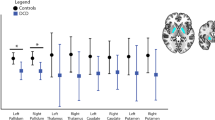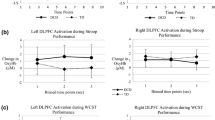Abstract
This study examined brain activation in children with developmental coordination disorder (DCD) to reveal areas that may contribute to poor movement execution and/or abundant motor overflow. Using functional magnetic resonance imaging, 13 boys with DCD (mean age = 9.6 years ±0.8) and 13 typically developing controls (mean age = 9.3 years ±0.6) were scanned performing two tasks (finger sequencing and hand clenching) with their dominant hand, while a four-finger motion sensor recorded contralateral motor overflow on their non-dominant hand. Despite displaying increased motor overflow on both functional tasks during scanning, there were no obvious activation deficits in the DCD group to explain the abundant motor overflow seen. However, children with DCD were found to display decreased activation in the left superior frontal gyrus on the finger-sequencing task, an area which plays an integral role in executive and spatially oriented processing. Decreased activation was also seen in the left inferior frontal gyrus, an area typically active during the observation and imitation of hand movements. Finally, increased activation in the right postcentral gyrus was seen in children with DCD, which may reflect increased reliance on somatosensory information during the execution of complex fine motor tasks.




Similar content being viewed by others
References
American Psychiatric Association (2000) Diagnostic and statistical manual of mental disorders: 4th edition, text revision. American Psychiatric Association, Washington DC
American Psychiatric Association (2013) Diagnostic and statistical manual of mental disorders, 5th edn. American Psychiatric Association, Washington DC
Andreasen NC, O’Leary DS, Cizadlo T, Arndt S, Rezai K, Boles Ponto LL et al (1996) Schizophrenia and cognitive dysmetria: a positron-emission tomography study of dysfunctional prefrontal-thalamic-cerebellar circuity. Proc Natl Acad Sci 3:9985–9990
Binkofski F, Buccino G, Posse S, Seitz RJ, Rizzolatti G et al (1999a) A fronto-parietal circuit for object manipulation in man: evidence from an fMRI-study. Eur J Neurosci 11:3276–3286. doi:10.1046/j.1460-9568.1999.00753.x
Binkofski F, Buccino G, Stephan KM, Rizzolatti G, Seitz RJ et al (1999b) A parieto-premotor network for object manipulation: evidence from neuroimaging. Exp Brain Res 128:210–213. doi:10.1007/s002210050838
Blank R, Smits-Engelsman B, Polatajko HJ, Wilson PH (2012) Recommendations on the definition, diagnosis and intervention of developmental coordination disorder. Dev Med Child Neurol 54:54–93. doi:10.1111/j.1469-8749.2011.04171.x
Cairney J, Veldhuizen S, Szatmari P (2010) Motor coordination and emotional-behavioral problems in children. Curr Opin Psychiatry 23:324–329. doi:10.1097/YCO.0b013e32833aa0aa
Dewey D, Cantell M, Crawford SG (2007) Motor and gestural performance in children with autism spectrum disorders, developmental coordination disorder, and/or attention deficit hyperactivity disorder. J Int Neuropsychol Soc 13:246–256. doi:10.10170/S1355617707070270
Du Boisgueheneuc F, Levy R, Volle E, Seassau M, Duffau H, Kinkingnehun S et al (2006) Functions of the left superior frontal gyrus in humans: a lesion study. Brain 129:3315–3328. doi:10.1093/brain/awl244
Elbasan B, Kayihan H, Dusgun I (2012) Sensory integration and activities of daily living in children with developmental coordination disorder. Ital J Pediatr 38:14. doi:10.1186/1824-7288-38-14
Henderson SE, Sugden DA, Barnett AL (2007) Movement assessment battery for children-2, 2nd edn. The Psychological Corporation, London
Kashiwagi M, Iwaki S, Narumi Y, Tamai H, Suzuki S (2009) Parietal dysfunction in developmental coordination disorder. Neuroreport 20:1319–1324. doi:10.1097/WNR.0b013e32832f4d87
Kuhtz-Buschbeck J, Krumlinde Sundholm L, Eliasson A, Forssberg H (2000) Quantitative assessment of mirror movements in children and adolescents with hemiplegic cerebral palsy. Dev Med Child Neurol 42:728–736. doi:10.1111/j.1469-8749.2000.tb00034.x
Largo RH, Caflisch JA, Hug F, Muggli K, Molnar AA, Molinari L (2001) Neuromotor development from 5 to 18 years. Part 2: associated movements. Dev Med Child Neurol 43:444–453. doi:10.1111/j.1469-8749.2001.tb00740.x
Largo RH, Fischer JE, Rousson V (2003) Neuromotor development from kindergarten age to adolescence:developmental course and variability. Swiss Med Wkly 133:193–199
Licari M, Larkin D (2008) Increased associated movement: influence of attention deficits and movement difficulties. Hum Mov Sci 27:310–324. doi:10.1016/j.humov.2008.02.013
Licari M, Larkin D, Miyahara (2006) The influence of developmental coordination disorder and attention deficits on associated movements in children. Hum Mov Sci 25:90–99. doi:10.1016/j.humov.2005.10.012
MacNeil LK, Xavier P, Garvey MA, Gilbert DL, Ranta ME, Denckla MB et al (2011) Quantifying excessive mirror overflow in children with attention-deficit/hyperactivity disorder. Neurology 76:622–628. doi:10.1212/WNL.0b013e31820c3052
Mariën P, Wackenier P, De Surgeloose D, De Deyn PP, Verhoeven J (2010) Developmental coordination disorder: disruption of the cerebello-cerebral network evidenced by SPECT. Cerebellum 9:405–410. doi:10.1007/s12311-010-0177-6
Mostofsky SH, Rimrodt SL, Schafer JGB, Boyce A, Goldberg MC, Pekar JJ et al (2006) Atypical motor and sensory cortex activation in attention-deficit/hyperactivity disorder: a functional magnetic resonance imaging study of simple sequential finger tapping. Biol Psychiatry 59:48–56. doi:10.1016/j.biopsych.2005.06.011
Mouchet-Mages S, Rodrigo S, Cachia A, Mouaffak F, Oliel JP, Meder JF et al (2011) Correlations of cerebello-thalamo cortical-prefrontal structure and neurological soft signs in patients with first-episode psychosis. Acta Psychiatr Scand 123:451–458. doi:10.1111/j.1600-0447.2010.01667.x
Oldfield RC (1971) The assessment and analysis of handedness: the Edinburgh inventory. Neuropsychologia 9:97–113. doi:10.1016/0028-3932(71)90067-4
Ozbič M, Filipčič T (2010) Complex imitation of gestures in school-aged children with learning difficulties. Kinesiology 4:44–55
Piek JP, Dyck MJ, Francis M, Conwell A (2007) Working memory, processing speed, and set-shifting in children with developmental coordination disorder and attention-deficit-hyperactivity disorder. Dev Med Child Neurol 49:678–683. doi:10.1111/j.1469-8749.2007.00678.x
Querne L, Berquin P, Vernier-Hauvette M-P, Fall S, Deltour L, Meyer M-E et al (2008) Dysfunction of the attentional brain network in children with developmental coordination disorder: a fMRI study. Brain Res 1244:89–102. doi:10.1016/j.brainres.2008.07.066
Venkatasubramanian G, Jayakumar PN, Gangadhar BN (2008) Neuroanatomical correlates of neurological soft signs in antipsychotic-naive schizophrenia. Psychiatry Res 164:215–222. doi:10.1016/j.pscychresns.2007.12.021
Werner JM, Cermak SA, Aziz Zadeh L (2012) Neural correlates of developmental coordination disorder: the mirror neuron system hypothesis in children and adolescents. J Behav Brain Sci 2:258–268. doi:10.4236/jbbs.2012.22029
Wolraich ML (2013) Vanderbilt ADHD parent rating scale. American Academy of Pediatrics and the National Initiative for Children’s Healthcare Quality, Cambridge
World Health Organisation (2012) ICD-10 classifications of mental and behavioural disorder: clinical descriptions and diagnostic guidelines. World Health Organisation, Geneva
Zwicker JG, Missiuna C, Boyd LA (2009) Neural correlates of developmental coordination disorder: a review of hypotheses. J Child Neurol 24:1273–1281. doi:10.1177/0883073809333537
Zwicker J, Missiuna C, Harris R, Boyd LA (2010) Brain activation of children with developmental coordination disorder is different than peers. Pediatrics 126:e678–e686. doi:10.1542/peds.2010-0059
Zwicker J, Missiuna C, Harris R, Boyd LA (2011) Brain activation associated with motor skill practice in children with developmental coordination disorder: an fMRI study. Int J Dev Neurosci 29:145–152. doi:10.1016/j.ijdevneu.2010.12.002
Acknowledgments
The authors would like to thank the radiology staff from Sir Charles Gairdner Hospital and Princess Margaret hospital involved in this project, and the children and parents for their time and participation. We would also like to thank Mag Design and Engineering who created the motion sensor glove. This project was funded by a Research Development Award from the University of Western Australia.
Conflict of interest
The authors declare they have no conflict of interest.
Ethical standard
All procedures performed in studies involving human participants were in accordance with the ethical standards of the Human Research Ethics Committees at the University of Western Australia (RA/4/1/2572) and Princess Margaret Hospital for Children (1804) and with the 1964 Helsinki declaration and its later amendments or comparable ethical standards.
Informed consent
Informed consent was obtained from all parents/guardians and verbal assent from individual participants included in the study.
Author information
Authors and Affiliations
Corresponding author
Rights and permissions
About this article
Cite this article
Licari, M.K., Billington, J., Reid, S.L. et al. Cortical functioning in children with developmental coordination disorder: a motor overflow study. Exp Brain Res 233, 1703–1710 (2015). https://doi.org/10.1007/s00221-015-4243-7
Received:
Accepted:
Published:
Issue Date:
DOI: https://doi.org/10.1007/s00221-015-4243-7




